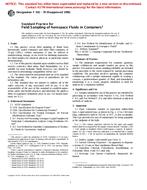1.1 This guide covers methods for selection and application of coal combustion products (CCPs) for use in the chemical stabilization of trace elements in wastes and wastewater. These elements include, but are not limited to, arsenic, barium, boron, cadmium, chromium, cobalt, lead, molybdenum, nickel, selenium, vanadium, and zinc. Chemical stabilization may be accompanied by solidification of the waste treated. Solidification is not a requirement for the stabilization of many trace elements, but does offer advantages in waste handling and in reduced permeability of the stabilized waste.
1.1.1 Solidification is an important factor in treatment of wastes and especially wastewaters. Solidification/Stabilization (S/S) technology is often used to treat wastes containing free liquids. This guide addresses the use of CCPs as a stabilizing agent without the addition of other materials; however, stabilization or chemical fixation may also be achieved by using combinations of CCPs and other products such as lime, lime kiln dust, cement kiln dust, cement, and others. CCPs used alone or in combination with other reagents promote stabilization of many inorganic constituents through a variety of mechanisms. These mechanisms include precipitation as carbonates, silicates, sulfates, and so forth; microencapsulation of the waste particles through pozzolanic reactions; formation of metal precipitates; and formation of hydrated phases (1-4).2 Long-term performance of the stabilized waste is an issue that must be addressed in considering any S/S technology. In this guide, several tests are recommended to aid in evaluating the long-term performance of the stabilized wastes.
Product Details
- Published:
- 12/01/2014
- Number of Pages:
- 8
- File Size:
- 1 file , 120 KB


